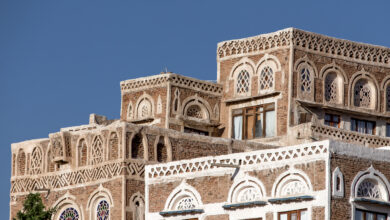“Intuited Happiness,” the latest exhibition by artist Islam Zaher, attempts to highlight the vivid contrast that exists in the Egyptian society between what can be revealed and what must remain hidden.
In the show, which opened last Wednesday at the Karim Francis contemporary art gallery in downtown Cairo, Zaher offers the viewer two sets of artwork, two moods, two universes that collide and, ultimately, reject one another.
Zaher depicts the schizophrenia that prevails in Egyptian society through a mixture of large paintings filled with bright colors and minimalistic drawings in various shades of brown.
“Through this work I intended to express the contradiction between inner and outer, between sexuality that has to be kept hidden and what you can show to the world,” says Zaher. The contrast is as striking as it is disturbing.
The eye is naturally drawn first to the colorful paintings that represent loud and bright Egyptian celebrations under rows of flickering bulbs and the thick khayameyya canvas of the tent. In one painting, a bride stands, small and dull in her fluffy white wedding dress, while the power of the celebration seems to crush her thin figure. The artist has stressed her state of dismay and anxiety by first drawing her in charcoal on textured paper and then scanning the figure and gluing her on the painting.
In the end, the viewer feels that instead of being the focal point of the celebration, she is withering away for the benefit of the celebration. “Traditions in Egyptian society are so overwhelming that they have some kind of power that prevents individuals from being in the spotlight,” explains Zaher. “Maybe we Egyptians are too old to move on, we are burdened by traditions.”
Another painting depicts a paunchy belly dancer caught dancing mechanically, her face a grey blur of indistinguishable features. The motion of her chubby silhouette is highlighted by brushstrokes of brightly colored paint, while her body remains dull and grey, almost metallic. Her navel, drowning in her sea of flesh, is a black hole while her large breasts are contained in a flax bodice.
“It is not forbidden to show a belly dancer, it is no different than a woman in a niqab. It is an acceptable attire in a certain context,” Zaher says.
“I chose to include this series of paintings in a very Egyptian context by introducing pieces of khayameyya and flax, the traditional fabric used to wrap mummies, while the drawings have a universal feel to them.”
Nearby, a set of four small-scale drawings represent the act of love.
The artist has drawn the intricate shape of the bodies with thin lines of brown ink complimented by thicker strokes of brown watercolor underlining certain details of the drawing while disguising others, like a veil of modest. The bodies, which are not very discernible, are entangled in such a way that they become almost organic, like a polished stone or a mesh of roots.
Zaher’s work also displays a clear influence of calligraphy through the use of diamond-shaped dots sprinkled on the various drawings.
“I do not consider myself a calligrapher,” the artist says. “I integrated this stylistic device to my work because of its relation to the holy scriptures that hold the keys to happiness by giving advice on how to reach it, even though the message is often unclear and foggy.”
It seems that the artist is asking himself a question: Can happiness be reached through the mystic and holy act of love?
Zaher says of “Intuited Happiness”: “Finally, I broke free from all the academic ties that were somehow holding me until now. Today, I feel closer to my proper identity.”
Islam Zaher “Intuited Happiness”
Solo exhibition 7 April-26 May
Karim Francis contemporary art gallery-1, el-Sherifein st downtown
Saturday-Thursday 1-8 pm




